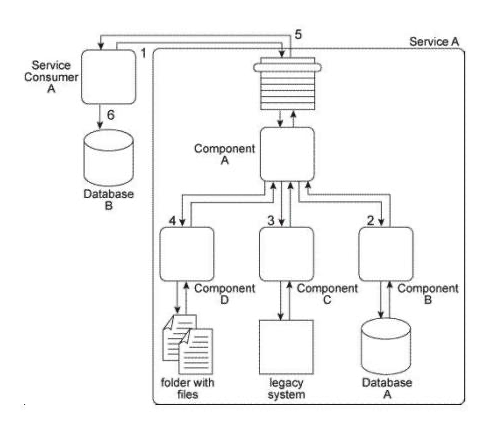When Service A receives a message from Service Consumer A(1) ,the message is processed by Component A. This component first invokes Component B (2) , which uses values from the message to query Database A in order to retrieve additional data. Component B then returns the additional data to Component A. Component A then invokes Component C (3) , which interacts with the API of a legacy system to retrieve a new data value. Component C then returns the data value back to Component A. Next, Component A sends some of the data it has accumulated to Component D (4) , which writes the data to a te>X file that is placed in a specific folder. Component D then waits until this file is imported into a different system via a regularly scheduled batch import. Upon completion of the import, Component D returns a success or failure code back to Component A. Component A finally sends a response to Service Consumer A (5) containing all of the data collected so far and Service Consumer A writes all of the data to Database B (6) . Components A, B, C. and D belong to the Service A service architecture. Database A, the legacy system, and the file folders are shared resources within the IT enterprise.  Service A is an entity service with a service architecture that has grown over the past few years. As a result of a service inventory-wide redesign project, you are asked to revisit the Service A service architecture in order to separate the logic provided by Components B, C, and D into three different utility services without disrupting the behavior of Service A as it relates to Service Consumer A . What steps can be taken to fulfill these requirements?
Service A is an entity service with a service architecture that has grown over the past few years. As a result of a service inventory-wide redesign project, you are asked to revisit the Service A service architecture in order to separate the logic provided by Components B, C, and D into three different utility services without disrupting the behavior of Service A as it relates to Service Consumer A . What steps can be taken to fulfill these requirements?
A) The Legacy Wrapper pattern can be applied so that Component B is separated into a separate wrapper utility service that wraps the shared database. The Asynchronous Queuing pattern can be applied so that a messaging queue is positioned between Component A and Component C, thereby enabling communication during times when the legacy system may be unavailable or heavily accessed by other parts of the IT enterprise. The Service Facade pattern can be applied so that a Facade component is added between Component A and Component D so that any change in behavior can be compensated. The Service Autonomy principle can be further applied to Service A to help make up for any performance loss that may result from splitting the component into a separate wrapper utility service.
B) The Legacy Wrapper pattern can be applied so that Component B is separated into a separate utility service that wraps the shared database. The Legacy Wrapper pattern can be applied again so that Component C is separated into a separate utility service that acts as a wrapper for the legacy system API. The Legacy Wrapper pattern can be applied once more to Component D so that it is separated into another utility service that provides standardized access to the file folder. The Service Facade pattern can be applied so that three Facade components are added: one between Component A and each of the new wrapper utility services. This way, the Facade components can compensate for any change in behavior that may occur as a result of the separation. The Service Composability principle can be further applied to Service A and the three new wrapper utility services so that all four services are optimized for participation in the new service composition. This will help make up for any performance loss that may result from splitting the three components into separate services.
C) The Legacy Wrapper pattern can be applied so that Component B is separated into a separate utility service that wraps the shared database. The Legacy Wrapper pattern can be applied again so that Component C is separated into a separate utility service that acts as a wrapper for the legacy system API. Component D is separated into a separate service and the Event-Driven Messaging pattern is applied to establish a publisher-subscriber relationship between this new service and Component A. The interaction between Service Consumer A and Component A is then redesigned so that Component A first interacts with Component B and the new wrapper service. Service A then issues a final message back to Service Consumer A. The Service Composability principle can be further applied to Service A and the three new wrapper utility services so that all four services are optimized for participation in the new service composition. This will help make up for any performance loss that may result from splitting the three components into separate services.
D) None of the above.
Correct Answer:
Verified
Q8: Our service inventory contains the following three
Q9: It has been confirmed that Policy A
Q10: You are told that in this service
Q11: Service A is a utility service that
Q12: Service A is a task service that
Q14: Service A is a utility service that
Q15: Service A is a task service that
Q16: Service A is an entity service that
Q17: Services A, B, and C are non-agnostic
Q18: Service A is a task service that
Unlock this Answer For Free Now!
View this answer and more for free by performing one of the following actions

Scan the QR code to install the App and get 2 free unlocks

Unlock quizzes for free by uploading documents